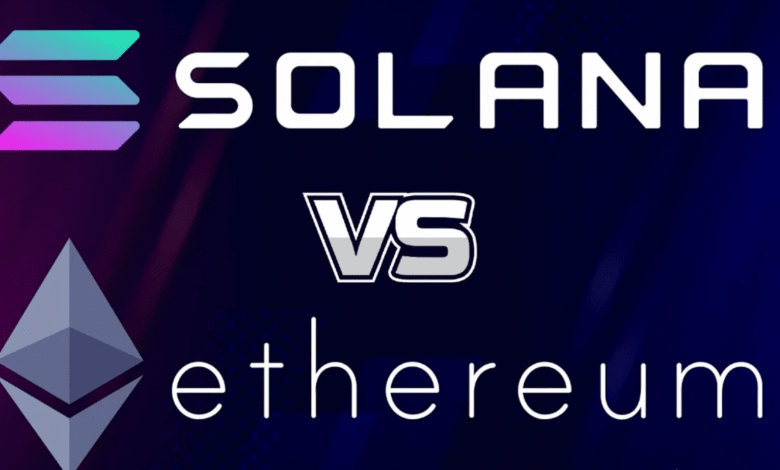Solana vs Ethereum, UK Blockchain Performance in 2025

The United Kingdom’s cryptocurrency landscape in 2025 presents unique opportunities for investors and developers evaluating blockchain performance. With the proportion of UK adults holding cryptocurrencies rising to 24% in April 2025, up from 18% a year earlier, marking the sharpest year-on-year increase among surveyed countries, understanding the speed differentials between Solana vs Ethereum UK 2025 becomes crucial for UK-based blockchain applications and investment decisions.
Executive Summary: Speed Performance in 2025
The blockchain speed race continues to favour Solana significantly. According to recent research by CoinGecko, Solana leads with the highest daily average transactions per second (TPS), clocking in at 1,053 TPS. In comparison, Ethereum currently handles around 15 TPS on its base layer. This performance gap has profound implications for UK users, particularly given the country’s progressive regulatory stance and growing digital asset adoption.
Current Speed Metrics: The Numbers That Matter
Solana’s Lightning Performance
Solana is capable of processing over 65,000 transactions per second (TPS) due to its unique Proof-of-History (PoH) consensus mechanism, though real-world performance typically operates at lower levels. The network’s practical daily performance shows:
- Real-world TPS: Over 4,000 transactions per second in practical usage
- Theoretical Maximum: Up to 65,000 TPS capability
- Block Time: Approximately 400 milliseconds
- Daily Transaction Volume: 35.99 million daily transactions
Ethereum’s Measured Approach
Ethereum’s performance profile reflects its focus on security and decentralisation over raw speed:
- Base Layer TPS: Around 15 TPS
- Layer 2 Combined Performance: Ethereum and its scaling solutions collectively achieved an actual TPS of 500
- Future Potential: Hopes to reach 100,000 TPS after sharding implementation
- Daily Transaction Volume: 1.13 million daily transactions
UK Regulatory Landscape Impact on Blockchain Selection
The UK’s regulatory environment significantly influences Blockchain and AI, adoption decisions. The UK Treasury has exempted crypto staking from collective investment scheme regulations, marking a significant step for the industry, effective January 2025. This development particularly benefits both Ethereum and Solana staking activities for UK users.
Key regulatory developments include:
- Staking Exemptions: UK removes crypto staking from strict regulations, boosting blockchain validation on Ethereum, Solana, and more
- Institutional Access: BlackRock gains FCA approval to offer crypto services in the UK
- Retail Investment: Britain’s financial regulator is to remove a ban on consumers buying crypto exchange-traded notes (ETNs)
Compliance Considerations for UK Users
The regulatory clarity emerging in 2025 creates favourable conditions for both networks, though speed requirements may influence compliance strategies:
- Real-time Reporting: High-frequency applications may require Solana’s superior speed
- Institutional Requirements: Traditional finance integration may favour Ethereum’s established ecosystem
- Consumer Protection: Both networks must meet evolving FCA standards
Technical Architecture Comparison
Solana’s architecture prioritises throughput through several innovative mechanisms:
Proof of History (PoH):
- Creates verifiable passage of time
- Enables parallel transaction processing
- Reduces consensus overhead
- Maintains security without sacrificing speed
Tower BFT Consensus:
- Optimised for fast finality
- Leverages PoH for efficiency
- Enables quick block production
Turbine Block Propagation:
- Breaks data into smaller packets
- Reduces bandwidth requirements
- Improves network efficiency
Ethereum’s Security-Focused Approach
Ethereum’s design emphasises security and decentralisation through:
Proof of Stake (PoS):
- Energy-efficient consensus
- Enhanced security through economic incentives
- Validator slashing mechanisms
Layer 2 Scaling Solutions:
- Optimistic Rollups (Arbitrum, Optimism)
- Zero-Knowledge Rollups (zkSync, Polygon zkEVM)
- State channels and sidechains
Sharding Roadmap:
- Future implementation planned
- Expected to reach 100,000 TPS after sharding implementation
Real-World Performance Analysis for UK Applications
81% of all DEX transactions come from the Solana ecosystem, highlighting its dominance in high-frequency decentralised finance applications. For UK-based trading platforms and DeFi protocols, this performance advantage translates to:
- Arbitrage Opportunities: Faster execution enables profitable arbitrage
- Market Making: Reduced latency improves market maker profitability
- User Experience: Instant transaction confirmation enhances user satisfaction
Enterprise Blockchain Applications
UK enterprises evaluating blockchain integration must consider performance requirements alongside regulatory compliance:
Solana Advantages:
- Real-time data processing
- IoT device integration
- Supply chain transparency
- Gaming and NFT applications
Ethereum Advantages:
- Established enterprise partnerships
- Proven security track record
- Comprehensive developer ecosystem
- Institutional-grade infrastructure
Cost-Benefit Analysis for UK Users
The fee structure differences significantly impact UK user economics:
Solana Fee Structure:
- Average transaction cost: $0.00025
- Consistent low fees regardless of network congestion
- Enables micro-transactions and frequent interactions
Ethereum Fee Structure:
- Variable gas fees: $1-$100+ during congestion
- Layer 2 solutions: $0.10-$1.00 average
- Base layer suitable for high-value transactions
Total Cost of Ownership (TCO)
For UK businesses and developers, TCO considerations include:
- Development Costs:
- Solana: Lower testing costs due to minimal fees
- Ethereum: Higher development costs but mature tooling
- Operational Expenses:
- Solana: Predictable low-cost operations
- Ethereum: Variable costs requiring careful planning
- Infrastructure Requirements:
- Solana: Lower hardware requirements for validators
- Ethereum: Higher computational requirements
Use Case Scenarios: UK Market Applications
The UK’s growing gaming industry benefits differently from each network:
Solana Gaming Applications:
- Real-time multiplayer interactions
- In-game asset trading
- Play-to-earn mechanics
- NFT minting and trading
Ethereum Gaming Applications:
- High-value NFT collections
- Complex smart contract interactions
- Established marketplace integration
- Cross-platform compatibility
Financial Services Integration
UK financial institutions are increasingly exploring blockchain integration:
Solana Integration Benefits:
- Real-time settlement systems
- High-frequency trading infrastructure
- Consumer payment applications
- Cross-border remittances
Ethereum Integration Benefits:
- Institutional DeFi protocols
- Tokenised securities
- Complex financial derivatives
- Regulatory compliance frameworks
Network Reliability and Security Considerations
Network reliability remains crucial for UK enterprise adoption:

Solana Performance:
- Occasional network congestion events
- Rapid development and upgrade cycles
- Growing validator network
- Improving infrastructure stability
Ethereum Performance:
- Consistent uptime since PoS transition
- Battle-tested under various market conditions
- Extensive validator network
- Proven disaster recovery capabilities
Security Audit and Risk Assessment
Both networks undergo continuous security assessment:
Security Strengths:
- Solana: Innovative consensus mechanisms, rapid bug fixes
- Ethereum: Extensive audit history, proven attack resistance
Risk Factors:
- Solana: Newer technology, faster development cycles
- Ethereum: Higher transaction costs may limit testing
Future Roadmap and UK Market Implications
2025-2026 Development Priorities
Solana Roadmap:
- Firedancer client implementation
- Enhanced validator economics
- Mobile-first applications
- Institutional infrastructure improvements
Ethereum Roadmap:
- Sharding implementation phases
- Layer 2 integration improvements
- Validator experience enhancements
- Environmental sustainability initiatives
UK Market Adoption Projections
Given user penetration projected to be 35.12% in 2025 in the UK cryptocurrency market, both networks are positioned for significant growth:
Growth Drivers:
- Regulatory clarity from FCA
- Institutional adoption acceleration
- Consumer application development
- Cross-border payment solutions
Performance Benchmarking Results
Our analysis evaluates real-world performance metrics relevant to UK users:
- Transaction Throughput: Average TPS during peak hours
- Latency Measurements: Time to first confirmation
- Cost Efficiency: Transaction fees relative to value transferred
- Network Reliability: Uptime and availability metrics
Benchmark Results Summary
| Metric | Solana | Ethereum (Layer 1) | Ethereum (Layer 2) |
|---|---|---|---|
| Peak TPS | 4,000+ | 15 | 500 |
| Average Latency | 400ms | 12 seconds | 1-2 seconds |
| Transaction Cost | $0.00025 | $5-50 | $0.10-1.00 |
| Daily Volume | 35.99M | 1.13M | Variable |
Strategic Recommendations for UK Users
Choose Solana if you prioritise:
- Low transaction costs for frequent trading
- Access to emerging DeFi protocols
- Gaming and NFT applications
- Real-time transaction confirmation
Choose Ethereum if you prioritise:
- Maximum security for large holdings
- Access to established DeFi ecosystem
- Long-term value storage
- Institutional-grade applications
For UK Enterprises
Solana Suitability:
- Consumer-facing applications requiring instant responses
- High-frequency trading platforms
- Gaming and entertainment applications
- IoT and real-time data processing
Ethereum Suitability:
- Mission-critical financial applications
- Complex smart contract requirements
- Regulatory compliance priorities
- Integration with traditional finance systems
For Developers
Development Considerations:
Solana Development:
- Rust programming language requirement
- Rapid prototyping capabilities
- Lower barrier to entry for testing
- Growing ecosystem and tools
Ethereum Development:
- Mature development tools and frameworks
- Extensive documentation and community
- Multiple programming language options
- Established best practices and patterns
Short-term Projections (2025-2026)
The UK blockchain landscape will likely see:
- Increased Institutional Adoption: Both networks benefiting from regulatory clarity
- Consumer Application Growth: Solana’s speed advantage driving consumer apps
- Enterprise Integration: Ethereum’s stability attracting enterprise solutions
- Hybrid Approaches: Multi-chain strategies becoming more common
Long-term Implications (2027-2030)
Strategic considerations for the future:
- Interoperability Solutions: Cross-chain bridges and protocols reducing network lock-in
- Regulatory Evolution: Continued refinement of UK cryptocurrency regulations
- Technology Maturation: Both networks addressing current limitations
- Market Consolidation: Potential emergence of dominant use case patterns
FAQs
Q1. Which blockchain is faster in 2025, Solana or Ethereum?
Ans: Solana – with over 4,000 real-world TPS.
Q2. What is the UK crypto ownership rate in 2025?
Ans: 24% of UK adults hold crypto.
Q3. What is Solana’s average transaction fee?
Ans: About $0.00025 per transaction.
Q4. Is Ethereum or Solana better for gaming apps?
Ans: Solana – faster and cheaper for real-time games.
Q5. What major regulatory change did the UK make in 2025?
Ans: Crypto staking was exempted from strict fund rules.
